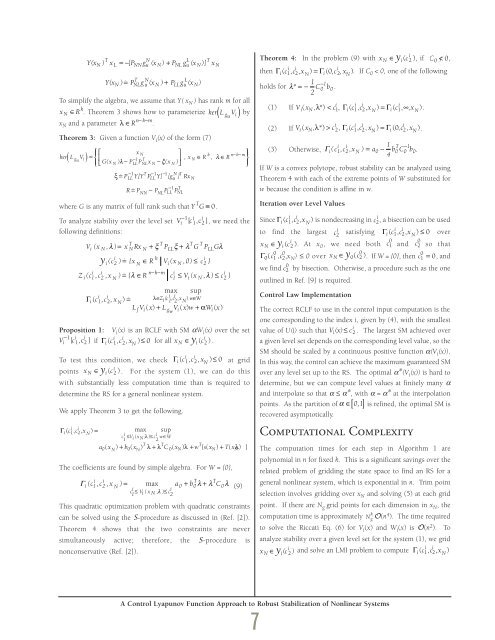1998 - Draper Laboratory
1998 - Draper Laboratory
1998 - Draper Laboratory
- No tags were found...
Create successful ePaper yourself
Turn your PDF publications into a flip-book with our unique Google optimized e-Paper software.
To simplify the algebra, we assume that Y( x N ) has rank m for allkxN∈R. Theorem 3 shows how to parameterize ker( L g uVi) byx N and a parameter λ∈R n−k−m.Theorem 3: Given a function V i (x) of the form (7)( ) =ker L V gu iY(x N ) T x L =− [PNNg u N (x N) + PNLg u L (x N )] T xNT N LY(x N ) = ˙ PNLg u (x N ) + P LL g u (x N )⎧⎪⎡x N⎤k n−k−m⎫⎪⎨ ⎢−1 T⎥ , x N ∈R , λ ∈R⎬⎩⎪ ⎣ Gx ( N ) λ−PLLPNLxN−ξ( xN) ⎦⎭⎪ξ= − 1 TLL− 1 − 1 NTLL u˙ P Y[Y P Y] [g ] Rx−1 TNN NL LL NLR= ˙ P − P P Pwhere G is any matrix of full rank such that Y T G≡ 0.To analyze stability over the level set Vi−1 i i[ c 1 , c 2 ], we need thefollowing definitions:Vi x N x T T T T( , ) = NRx N + P LL + G P LL Gikiy i ( c2 ) = ˙ { xN∈RVi( xN, 0) ≤ c2}λ ξ ξ λ λi in−k−miiZi( c1, c2, x N ) = ˙ { λ ∈Rc1 ≤ V i ( xN, λ) ≤ c2}max supi iΓ i 1 N ˙Z i (ci1,ci( c ,c ,x ),xN ) w W2 = λ∈2∈LfVi( x) + Lg wVi( x) w+αWi( x)Proposition 1: V i (x) is an RCLF with SM αW i (x) over the setiVi ii−1 i i[ c if Γ i ( c1, c2, x N ) ≤ 0 for all xN∈ y1 , c 2 ]i( c2).i iTo test this condition, we check Γ i ( c1, c2, x N ) ≤ 0 at gridipoints xN∈ yi( c2). For the system (1), we can do thiswith substantially less computation time than is required todetermine the RS for a general nonlinear system.We apply Theorem 3 to get the following.i iΓ i ( c max sup1, c2 , x N ) =c i ≤V i ( x N , λ ) ≤c i w∈W1 2T TTa0( xN) + b0( xN) λ+ λ C 0( xN) λ + w [ s( xN) + T( xNλ) ]The coefficients are found by simple algebra. For W = {0},i iT TΓ i ( c 1, c 2, x N ) = max a b C (9)c1 i V i ( x N , ) c2i 0 + 0λ+λ 0λ≤ λ ≤This quadratic optimization problem with quadratic constraintscan be solved using the S-procedure as discussed in (Ref. [2]).Theorem 4 shows that the two constraints are neversimultaneously active; therefore, the S-procedure isnonconservative (Ref. [2]).NiTheorem 4: In the problem (9) with xN∈ i( c2), if C 0 ≮ 0,i iithen Γi( c1, c2, xN ) = Γi( 0, c2, x N ). If C 0 < 0, one of the following1 −holds for λ* =− C .2 01 b0i i ii(1) If Vi( xN, λ *) < c 1, Γi( c1, c2, xN) = Γi( c1, ∞, xN).i i ii(2) If Vi( xN, λ *) > c 2, Γi( c1, c2, xN) = Γi( 0, c2, xN).i i1 T −(3) Otherwise, Γ i ( c1, c2, xN) = a0 − b0C0 1 b0.4If W is a convex polytope, robust stability can be analyzed usingTheorem 4 with each of the extreme points of W substituted forw because the condition is affine in w.Iteration over Level Valuesi iSince Γ is nondecreasing in c i i ( c1, c2, x N )2, a bisection can be usedi ito find the largest c2i satisfying Γ i ( c1, c2, x N ) ≤ 0 overi0 0xN∈ yi( c2). At x 0 , we need both c 1 and c 2 so that0 000Γ 0 ( c 1 , c 2 ,x N ) ≤ 0 over xN∈y0 ( c 2 ). If W = {0}, then c 1 = 0, and0we find c 2 by bisection. Otherwise, a procedure such as the oneoutlined in Ref. [9] is required.Control Law ImplementationThe correct RCLF to use in the control input computation is theone corresponding to the index i, given by (4), with the smallestivalue of U(i) such that V i(x)≤ c 2 . The largest SM achieved overa given level set depends on the corresponding level value, so theSM should be scaled by a continuous positive function α(V i (x)).In this way, the control can achieve the maximum guaranteed SMover any level set up to the RS. The optimal α ∗ (V i (x)) is hard todetermine, but we can compute level values at finitely many αand interpolate so that α ≤ α ∗ , with α = α ∗ at the interpolationpoints. As the partition of α ∈[ 01 , ] is refined, the optimal SM isrecovered asymptotically.Computational ComplexityThe computation times for each step in Algorithm 1 arepolynomial in n for fixed k. This is a significant savings over therelated problem of gridding the state space to find an RS for ageneral nonlinear system, which is exponential in n. Trim pointselection involves gridding over x N and solving (5) at each gridpoint. If there are N g grid points for each dimension in x N , thekcomputation time is approximately N O(n 4 g). The time requiredto solve the Riccati Eq. (6) for V i (x) and W i (x) is O(n 2 ). Toanalyze stability over a given level set for the system (1), we gridii ix N∈yi(c 2 ) and solve an LMI problem to compute Γ i ( c1, c2, x N )yA Control Lyapunov Function Approach to Robust Stabilization of Nonlinear Systems7
















